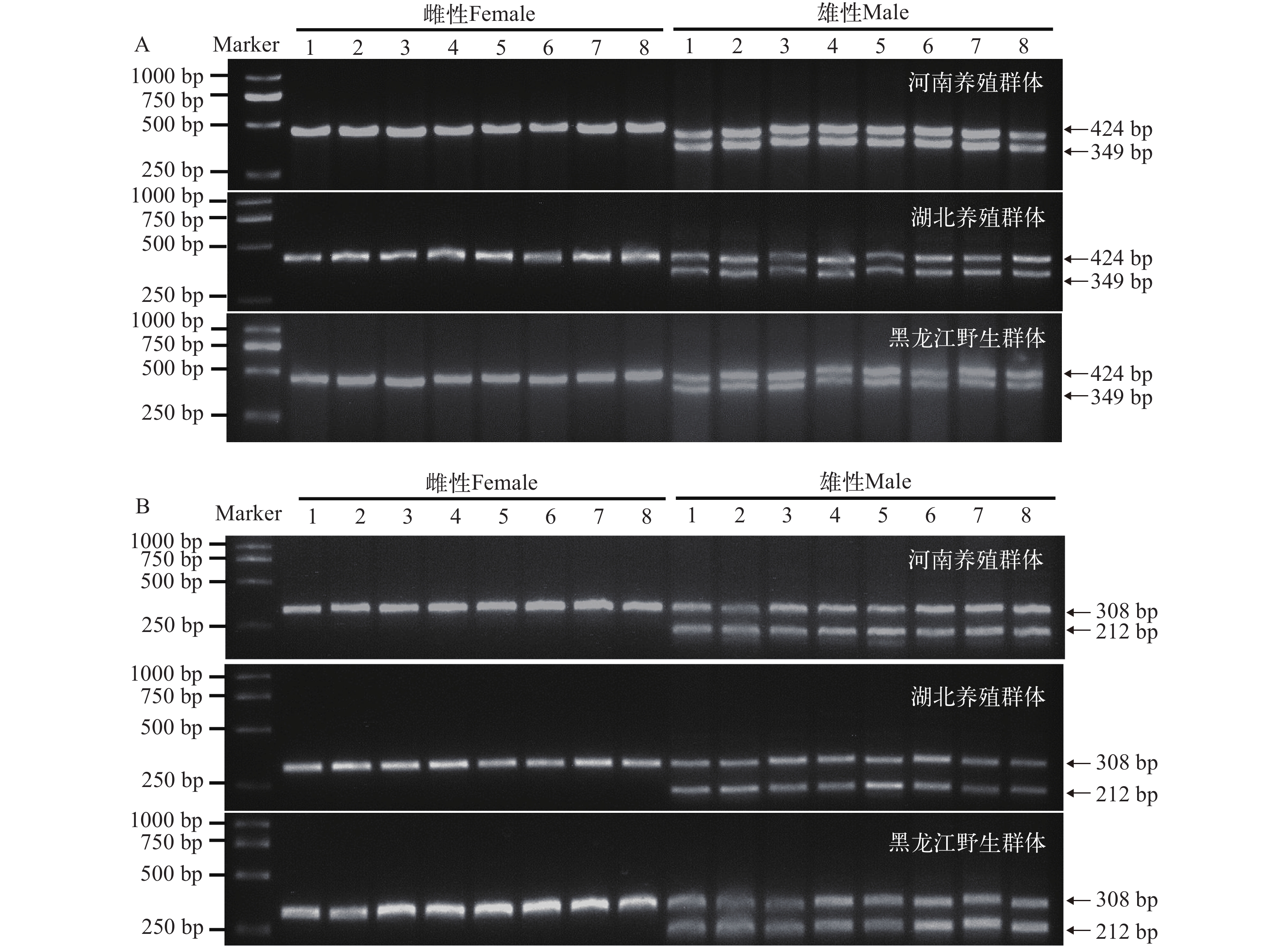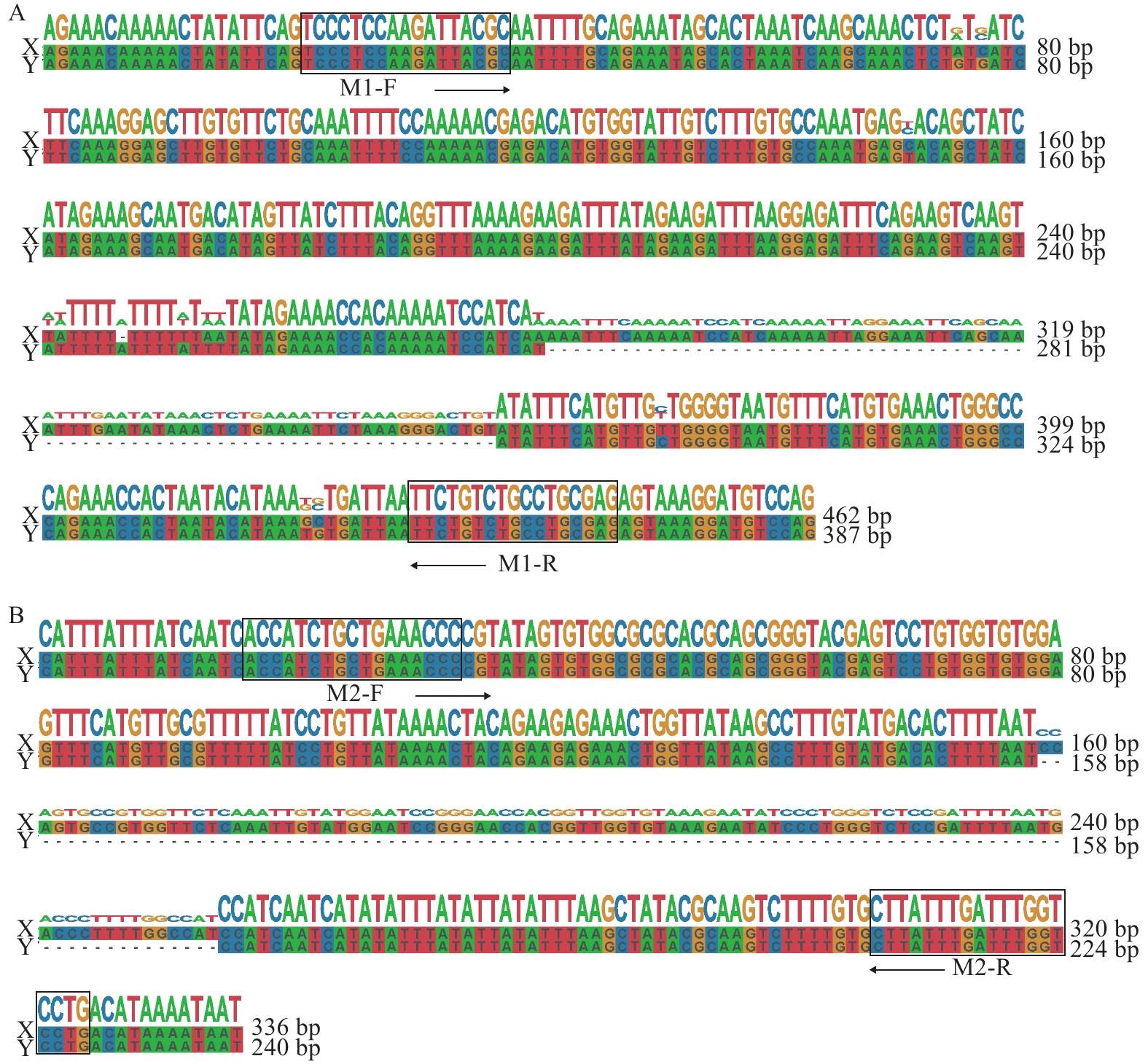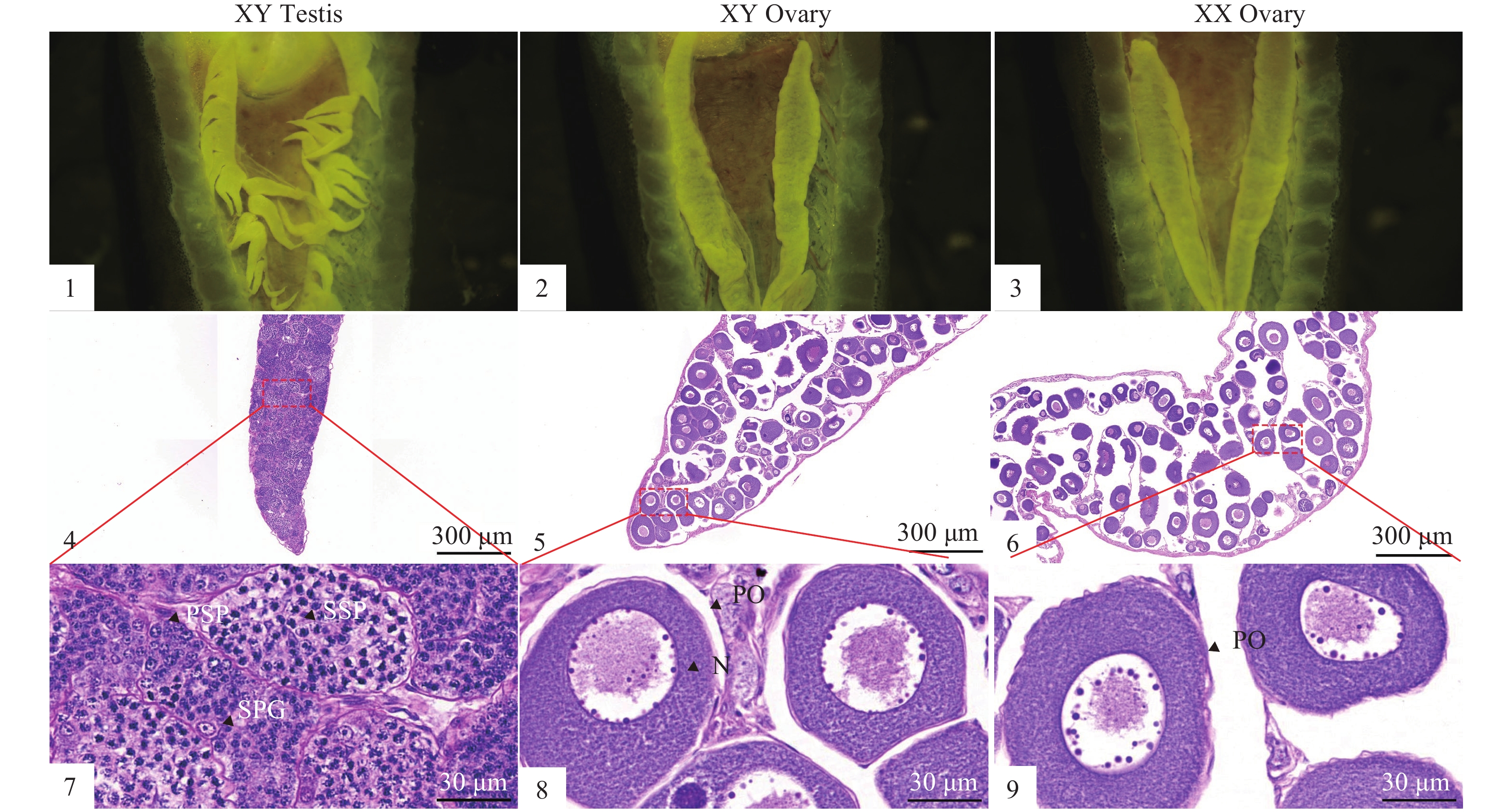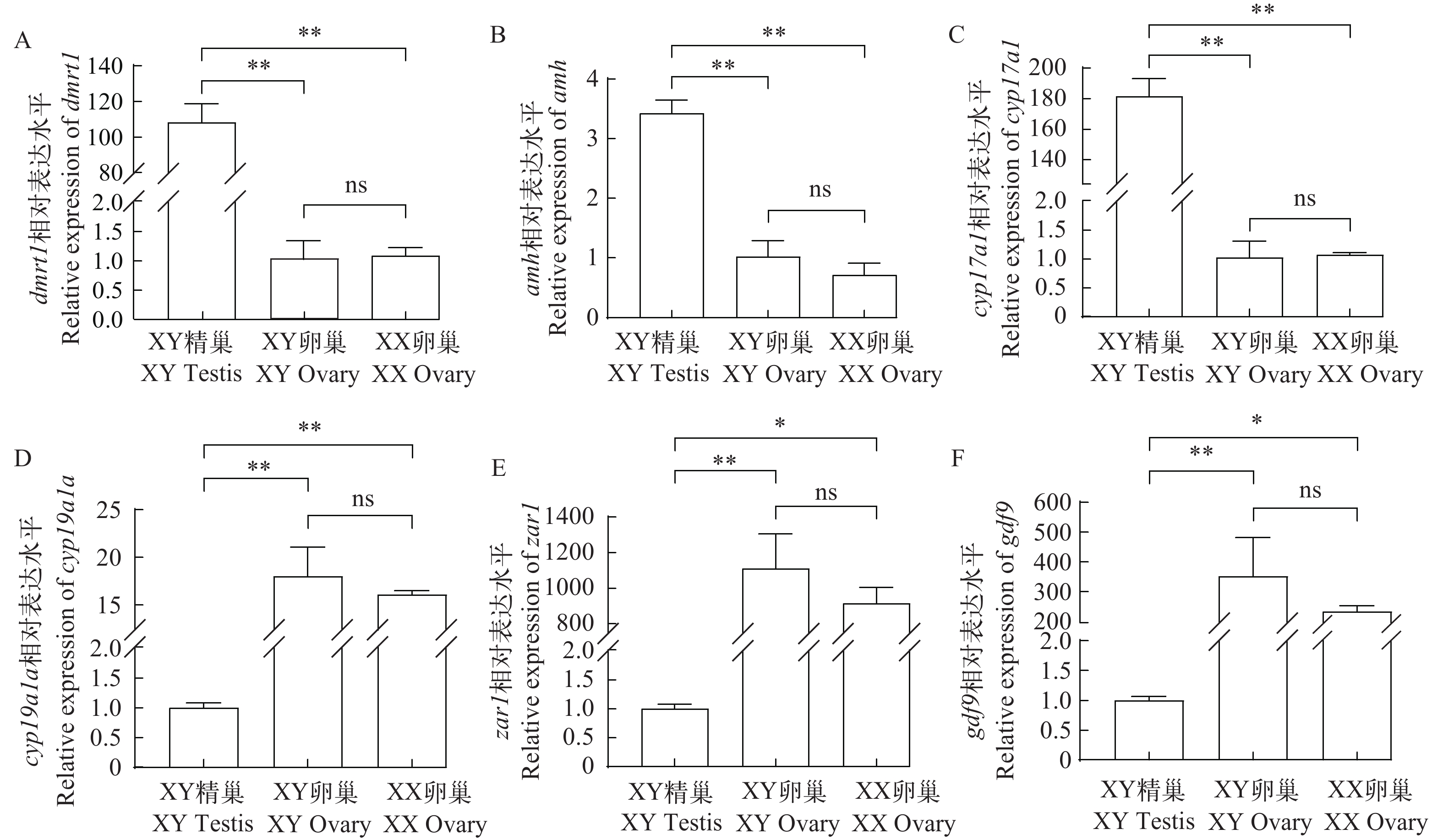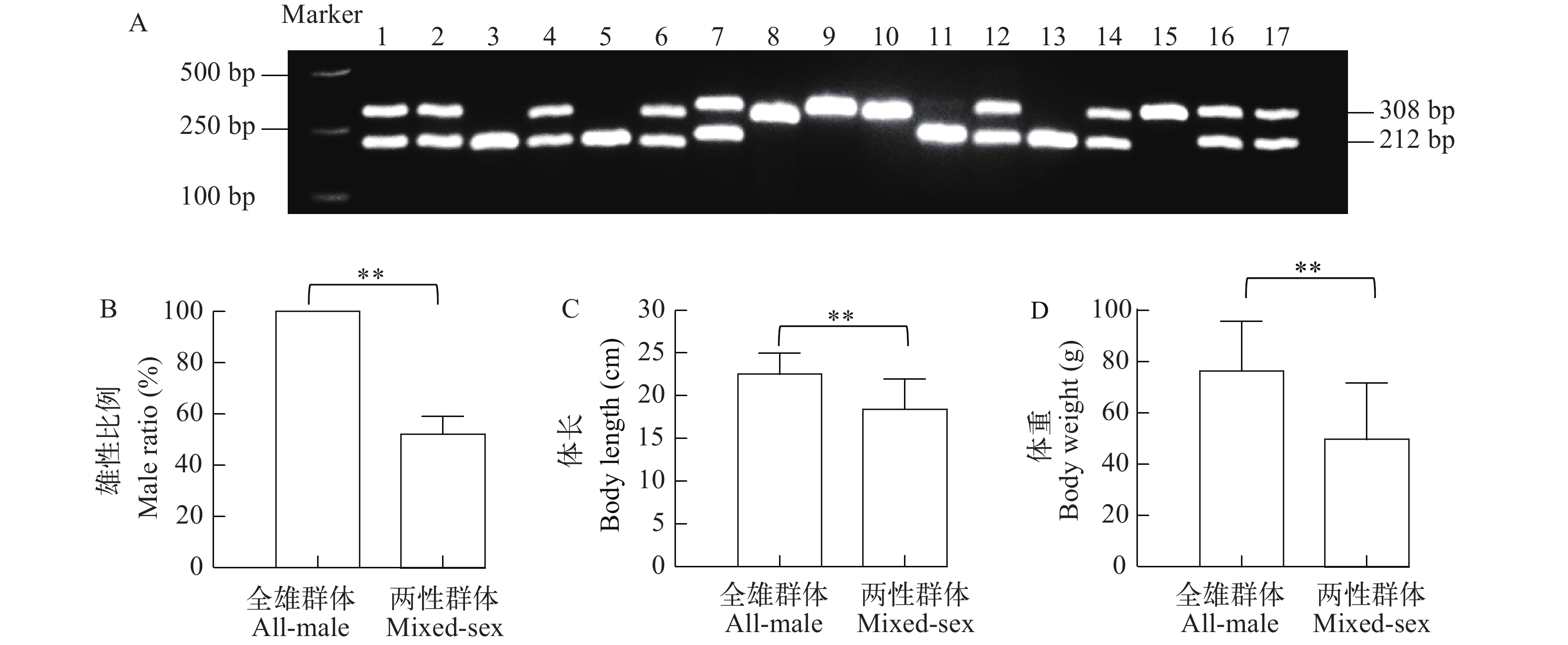PRODUCTION OF YY SUPER-MALE AND XY ALL-MALE PSEUDOBAGRUS USSURIENSIS BY SEX CONTROL TECHNOLOGY
-
摘要:
研究探索了17β-雌二醇(17β-estradiol, E2)的不同处理浓度和不同处理时间对乌苏里拟鲿(Pseudobagrus ussuriensis)生长、存活率和性比的影响。结果显示, 在10—70dph期间, 使用10、50和100 mg/kg E2投喂乌苏里拟鲿的雌性率高达100%, 但生长速度和存活率随E2浓度升高而降低, 投喂150 mg/kg E2组乌苏里拟鲿全部死亡。利用10 mg/kg E2投喂诱导乌苏里拟鲿100%雌性化的最佳时间为10—40dph。qRT-PCR结果显示雄性性别分化关键基因dmrt1、amh和cyp17a1在XY生理雌性的表达量显著低于XY雄性, 雌性性别分化关键基因cyp19a1a、zar1和gdf9在XY生理雌性的表达量与XX雌性一致, 显著高于XY雄性。此外, 利用全基因组重测序技术在15尾雌性和15尾雄性乌苏里拟鲿中共筛选到3777645个SNP和1287509个Indel, 其中有99601个性别连锁SNP和27614个性别连锁Indel。性别连锁的SNP主要集中在乌苏里拟鲿8号染色体6.84—23.82 Mb的位置。利用性别连锁的Indel开发了乌苏里拟鲿X和Y染色体特异的分子标记, 适用于黑龙江野生群体、河南和湖北的养殖群体。使用性别分子标记在XY雄性与XY雌性繁殖的子一代中鉴定出了YY超雄鱼, 使用YY超雄鱼为父本繁殖的乌苏里拟鲿雄性率为100%, 1年龄个体的体重是两性养殖群体的1.54倍。综上所述, 在10—40dph期间使用10 mg/kg E2诱导乌苏里拟鲿雌性化的效果最佳, 利用全基因组重测序技术开发的性别连锁分子标记能有效鉴定乌苏里拟鲿的遗传性别获得YY超雄鱼。研究创制的XY全雄乌苏里拟鲿与两性群体相比, 具有规格整齐和生长速度快的特点。
Abstract:In this study, we investigated the effects of various doses and treatment durations of 17β-estradiol (E2) on the growth, survival rate, and sex ratio of P. ussuriensis. From 10 to 70dph (days post-hatching), feeding P. ussuriensis diets containing 10, 50, and 100 mg/kg E2 resulted in a 100% feminization rate. However, the growth and survival rates decreased with increasing E2 concentration, and all fish in the group fed with 150 mg/kg E2 died. Overall, 10 mg/kg E2 treatment from 10 to 40dph was found to be the optimal approach for the feminization of P. ussuriensis. The expression levels of male key sex differentiation-related genes, such as dmrt1, amh, and cyp17a1, were significantly lower in XY females than that of XY males. The expression levels of female key sex differentiation-related genes including cyp19a1a, zar1, and gdf9 in XY females were consistent with those in XX females and were significantly higher than that in XY males. Additionally, whole-genome resequencing revealed 3777645 single nucleotide polymorphisms (SNPs) and 1287509 insertions/deletions (Indels) in 15 female and 15 male P. ussuriensis. Among these, 99601 were identified as sex-linked SNPs and 27614 as sex-linked Indels. The sex-linked SNPs were enriched in the 6.84 and 23.82 Mb regions of chromosome 8. X and Y chromosome specific molecular marker were developed based on sex-linked Indels, which proved effective for the sex identification in P. ussuriensis. These markers were well applied to wild populations from the Heilongjiang River as well as farmed populations in Henan and Hubei Province. YY super-male were identified from the offsprings of XY male mating with XY female. Subsequently, using YY super-male P. ussuriensis as the male parent, an all-male population was bred with a 100% male ratio. The all-male population at one-year old was 1.54 times heavier than the mixed-sex population. In summary, 10 mg/kg E2 treatment from 10 to 40dph is the optimal approach for the feminization of P. ussuriensis. The sex-linked molecular markers developed by whole-genome resequencing can effectively identify the genotype of P. ussuriensis and help produce YY super-male fish. XY all-male P. ussuriensis had the characteristics of uniform size and fast growth performance which will be more popular among farmers.
-
大黄鱼(Larimichthys crocea), 又称大黄花, 隶属硬骨鱼纲(Osteichthyes)的鲈形目(Perciformes), 石首鱼科(Sciaenidae), 黄鱼属(Larimichthys), 其肉质鲜美, 营养价值高, 主要分布在浙江、福建等沿海地区, 是我国东南沿海重要的养殖鱼类之一[1]。过去, 大黄鱼的养殖主要以投喂生物饵料为主, 而生物饵料的缺点突出, 如成本过高、成分不明、供应量不稳定、易携带病原微生物、容易污染水体等[2], 导致大黄鱼养殖业风险增加、收益减少, 在长远上限制了大黄鱼养殖业的健康发展。为了提高养殖经济效益, 大黄鱼人工配合饲料的研发刻不容缓。近年来, 由于渔业资源衰退和鱼粉需求量增加, 导致鱼粉价格上升[3], 而鱼粉在大黄鱼饲料中的配比又较高(>40%)[4, 5], 因而寻找价格低廉的优质蛋白源替代鱼粉至关重要。
本试验研究了5种新型非粮蛋白源, 分别为乙醇梭菌蛋白、小球藻、黑水虻粉、黄粉虫粉和棉籽浓缩蛋白。乙醇梭菌蛋白是以炼钢废气中的一氧化碳为碳源、氨水为氮源, 通过乙醇梭菌发酵产生的一种新型微生物蛋白, 其蛋白质含量高达85%, 且具有与鱼粉相似的氨基酸组成[6]。小球藻是一种富含蛋白质、多糖、不饱和脂肪酸、类胡萝卜素、虾青素、多种维生素和矿物质的微藻资源[7], 而经过破壁处理的小球藻蛋白质含量高达50%, 且其营养物质更容易被吸收利用[8]。乙醇梭菌蛋白和小球藻均属于单细胞蛋白, 也称微生物蛋白, 是从蛋白质含量较高的微生物细胞中分离出来的纯化蛋白[9], 可通过化工产业规模化生产, 该生产模式效率高, 是一种“变废为宝”的绿色可持续发展模式[10]。黑水虻是一种能将动物粪便、餐厨垃圾和其他有机废物有效转化成自身营养成分的双翅目昆虫, 其本身可作为家禽、牲畜、宠物和水生经济动物的饲料原料[11]。黑水虻粉蛋白质平均含量约为55%, 必需氨基酸组成平衡, 脂肪含量约为35%, 可通过脱脂过程将其降至5%—9%[12], 此外黑水虻粉中还富含ω-3多不饱和脂肪酸, 使其更适合饲喂肉食性海水鱼类[13]。黄粉虫粉是将活虫经过处死、灭菌、烘干、低温保存、加工等一系列过程而制成, 是高度可持续供给的新型昆虫蛋白源[14-16]。黄粉虫具有废物转化、节能减排的功能[15, 16], 其幼虫易繁殖, 且蛋白质含量高, 约为47%—60%, 在畜禽和水产饲料的应用中有巨大潜力[17, 18]。棉籽浓缩蛋白是指将脱壳的棉籽进行软化轧胚、低温烘干, 其次在甲醇和正己烷混合溶剂中脱酚提油得到的一种新型植物蛋白源[19]。其棉酚含量低, 且蛋白质含量高(>60%)[20], 是一种极具开发潜力的新型非粮蛋白源。
消化率是评价饲料原料营养价值的重要依据[21], 也是饲料配方设计的考虑因素之一[22], 对于提高经济效益和促进养殖业健康的发展具有重要意义。因此, 本试验通过指示剂法, 分析大黄鱼对乙醇梭菌蛋白、小球藻、黑水虻粉、黄粉虫粉和棉籽浓缩蛋白的干物质、蛋白质、脂肪、能量和氨基酸表观消化率。
1. 材料与方法
1.1 试验饲料
基础饲料以鱼粉、鸡肉粉、豆粕、玉米蛋白粉和大豆浓缩蛋白为主要蛋白源, 鱼油和豆油为主要脂肪源, 以0.1%的三氧化二钇(Y2O3)为外源指示剂, 并补充矿物质和维生素等配制基础饲料[22], 其配方见表 1。5种新型非粮蛋白源分别为乙醇梭菌蛋白(河北首朗新能源有限公司)、小球藻(中国科学院水生生物研究所)、黑水虻粉(广州飞禧特生物科技有限公司)、黄粉虫粉(广州泽合成生物科技有限公司)、棉籽浓缩蛋白(新疆金兰植物蛋白有限公司), 原料的营养水平和氨基酸组成分别见表 2和表 3。以质量分数为70%的基础饲料和30%的乙醇梭菌蛋白、小球藻、黑水虻粉、黄粉虫粉和棉籽浓缩蛋白配制成5种试验饲料。所有饲料原料均粉碎后过60目筛, 并按比例称量后逐级混匀, 然后加入20% 的水搅拌均匀, 用TSE-65双螺杆膨化机(北京现代洋工机械科技发展有限公司)制成粒径为5.0 mm的颗粒饲料, 在电热鼓风干燥箱(WGL-625B, 天津市泰斯特仪器有限公司)中60℃恒温干燥12h, 烘干后置于–20℃冰箱内备用。
表 1 基础饲料组成及营养水平(干物质基础%)Table 1. Composition and nutrient levels of foundational diets (dry-matter basis %)原料Ingredient 含量Content (%) 鱼粉Fish meal1 25.0 鸡肉粉Chicken meal 12.0 大豆浓缩蛋白Soyprotein concentrate 5.0 豆粕Soybean meal 16.0 玉米蛋白粉Corn gluten meal 6.0 高筋面粉Wheat flour 25.4 鱼油Fish oil 2.0 豆油Soybean oil 2.0 卵磷脂Lecithin 1.5 鱿鱼膏Squid paste 2.5 磷酸二氢钙Ca(H2PO4)2 1.0 维生素预混料Vitamin premix2 0.4 矿物质预混料Mineral premix3 0.5 维生素C Vitamin C 0.1 氯化胆碱Choline chloride 0.5 三氧化二钇Yttrium(Ⅲ)-oxide 0.1 营养水平Nutrient level4 水分Moisture 5.79 粗蛋白Crude protein 46.25 粗脂肪Crude lipid 4.45 灰分Ash 9.06 能量Gross energy (MJ/Kg) 19.06 注: 1鱼粉为秘鲁蒸汽鱼粉(粗蛋白含量≥67%)。2维生素预混料为每千克饲料提供: 硫胺素, 25 mg; 核黄素, 45 mg; 盐酸吡哆醇, 20 mg; 维生素B12, 0.1 mg; 维生素K3, 10 mg; 肌醇, 800 mg; 泛酸钙, 60 mg; 烟酰胺, 200 mg; 叶酸, 20 mg; 生物素, 1.2 mg; 维生素A乙酸酯, 32 mg; 维生素 D3, 5 mg; α-生育酚, 120 mg; 乙氧基喹啉, 150 mg; 玉米淀粉, 1511.7 mg. 3矿物质预混料为每千克饲料提供: 一水硫酸镁, 4000 mg; 一水硫酸锰, 50 mg;碘化钾(1%), 100 mg; 氯化钴(1%), 100 mg; 五水硫酸铜, 20 mg; 一水硫酸亚铁, 260 mg; 一水硫酸锌, 150 mg; 亚硒酸钠(1%), 50 mg。4营养水平均为实测值Note: 1The fish meal is Peruvian steam dried fish meal (crude protein content≥67%), and its quality is Japanese-grade. 2Vitamin premix provided the following per kg of diets: thiamin, 25 mg; riboflavin, 45 mg; hydrochloric acid pyridoxine, 20 mg; vitamin B12, 0.1 mg; vitamin K3, 10 mg; inositol, 800 mg; pantothenic acid, 60 mg; nicotinic acid, 200 mg; folic acid, 20 mg; biotin, 1.2 mg; retinal acetate, 32 mg; vitamin D3, 5 mg; alpha tocopherol, 120 mg; ethoxy quinoline, 150 mg; microcrystalline cellulose, 1511.7 mg. 3Mineral premix provided the following per kg of diets: MgSO4·H2O, 4000 mg; MnSO4·H2O, 50 mg; KI, 100 mg; CoCl2(1%), 100 mg; CuSO4·5H2O, 20 mg; FeSO4·H2O, 260 mg; ZnSO4·H2O, 150 mg; Na2SeO3(1%), 50 mg. 4Nutrient levels are all measured values 表 2 试验原料营养水平与鱼粉的比较(干物质基础%)Table 2. Nutrient levels of test ingredients (dry-matter basis %)原料
Ingredient乙醇梭
菌蛋白
CAP小球藻
CM黑水
虻粉
HM黄粉
虫粉
TM棉籽浓
缩蛋白
CPC鱼粉
FM营养水平Nutrient level 水分Moisture 2.47 9.11 2.28 2.67 5.09 5.79 粗蛋白Crude protein 84.54 54.29 34.20 66.30 63.05 68.00 粗脂肪Crude lipid 0.74 7.92 41.47 0.76 3.06 9.66 灰分Ash 6.98 8.26 10.15 9.04 8.73 9.06 能量Gross energy (MJ/kg) 21.89 21.62 24.36 20.33 18.98 22.43 表 3 试验原料氨基酸组成与鱼粉的比较(干物质基础%)Table 3. Amino acids compositions of test ingredients (dry-matter basis %)氨基酸
Amino acid乙醇
梭菌
蛋白
CAP小球藻
CM黑水
虻粉
HM黄粉
虫粉
TM棉籽
浓缩
蛋白
CPC鱼粉
FM必需氨基酸Essential amino acid 精氨酸Arg 3.43 2.92 1.22 3.93 7.78 3.87 组氨酸His 1.22 0.87 0.75 0.65 1.62 1.82 异亮氨酸Ile 4.98 1.54 1.31 2.65 1.66 4.86 亮氨酸Leu 6.06 4.02 2.31 4.74 3.23 2.85 蛋氨酸Met 2.32 1.17 0.61 1.15 0.88 1.67 赖氨酸Lys 7.40 2.84 1.94 4.89 2.57 4.78 苯丙氨酸Phe 3.17 2.34 1.31 3.01 3.10 3.09 苏氨酸Thr 4.40 2.32 1.24 2.30 1.84 2.33 色氨酸Trp 0.49 0.77 0.34 0.39 0.71 0.57 缬氨酸Val 5.09 2.68 1.82 3.99 2.59 3.54 非必需氨基酸Non-essential amino acid 丙氨酸Ala 4.87 3.99 2.52 3.09 2.18 4.11 天冬氨酸Asp 8.94 4.21 2.34 4.61 5.21 6.20 谷氨酸Glu 8.58 5.41 3.25 6.93 11.90 9.45 甘氨酸Gly 3.93 2.77 1.60 4.67 2.35 4.01 脯氨酸Pro 2.76 2.17 1.92 5.96 2.14 2.55 丝氨酸Ser 3.36 2.10 1.21 4.91 2.47 2.02 酪氨酸Tyr 2.96 1.60 1.73 1.88 1.42 1.78 胱氨酸Cys 1.37 0.77 0.38 2.14 1.09 0.52 必需氨基酸总量EAA 38.56 21.47 12.85 27.7 25.98 29.38 非必需氨基酸总量NEAA 36.77 23.02 14.95 34.19 28.76 30.64 氨基酸总量TAA 75.33 44.49 27.8 61.89 54.74 60.02 1.2 试验设计
试验所用大黄鱼为宁德市三都澳某大黄鱼育苗场培育的同一批鱼苗, 养殖试验于宁德市三都澳海上浮式网箱中进行。试验鱼运至鱼排后, 先置于养殖网箱中暂养1周, 暂养期间使用基础组饲料投喂以适应环境。正式试验开始前, 大黄鱼饥饿24h, 挑选体格健壮、规格一致的大黄鱼[(154.0±5.3) g]1800尾, 随机分到18个养殖网箱中(2.5 m×2.5 m×2 m), 每组3个重复, 每个重复100尾鱼, 其中对照组试验鱼投喂基础饲料, 试验组分别投喂5种试验饲料, 每天(6:00和18:00)饱食投喂2次, 当大多数鱼停止摄食时, 即达到了饱食。养殖周期为8周, 养殖期间水温20—24℃, pH为7.5—8.0, 溶解氧≥6 mg/L, 氨氮<0.1 mg/L。
1.3 样品收集
投喂试验饲料1周后, 采用挤压和解剖的方法收集后肠粪便样品, 其过程为将试验鱼进行解剖, 取出后肠, 再将粪便从后肠中轻轻挤压而出, 粪便经60℃烘干后, 用研钵研磨成粉末状, 放置在−20℃冰箱中保存。
1.4 样品的测定
原料、饲料和粪便样品中的水分、粗蛋白、粗脂肪和粗灰分的含量测定参照AOAC(2005)[23]的方法。样品的水分采用105℃恒温干燥法(DHG-9123A, 宁波江南仪器厂)测定; 粗蛋白采用凯氏定氮法测定; 粗脂肪采用索氏抽提法(无水乙醚为提取溶剂)测定; 粗灰分则通过马弗炉中550℃燃烧8h的灼烧法测定。饲料和粪便的能量采用全自动氧弹量热仪(Parr 6300)测定。矿物元素含量的测定方法为加酸微波消解(JUPITER-B, 多通量微波消解仪, 上海新仪微波化学科技有限公司), 然后稀释定容, 用电感耦合等离子体原子发射光谱仪(ICP-OES, Prodigy7, LEEMAE LABS, USA)测定。原料、饲料和粪便样品被冻干至恒重, 每个样品取30 mg放入15 mL 6 mol/L HCl溶液中, 在110℃下水解24h, 用全自动氨基酸分析仪(L-8900, Hitachi, Tokyo, Japan)测定其氨基酸含量。
1.5 计算公式
试验饲料干物质表观消化率(ADC, %)=(1–Dy/Fy)×100;
试验饲料营养成分表观消化率(ADC, %)=[1–(Fi/Di)×(Dy/Fy)]×100;
试验原料营养物质和能量的表观消化率(ADC, %)=ADC试验饲料+[(ADC试验饲料–ADC基础饲料)×(0.7×DR)/(0.3×DT)];
式中, Dy为饲料中钇的含量(%); Fy为粪便中钇的含量(%); Di为饲料中营养成分的含量(%); Fi为粪便中营养成分的含量(%); DR为基础饲料中营养成分的含量(%); DT为试验原料中营养成分的含量(%)。
1.6 数据分析与处理
所有试验数据使用SPSS 22.0统计软件进行One-way ANOVA分析, 采用Levene,s F检验方差齐次性, 并用Duncan氏法进行多重比较, 差异显著水平为P<0.05。所有试验数据均以平均值±标准误(mean±SE)的形式来表示。
2. 结果
2.1 大黄鱼对5种试验原料干物质、蛋白质、脂肪和能量的表观消化率
如表 4所示,大黄鱼对5种试验原料中干物质的表观消化率为56.77%—75.53%(乙醇梭菌蛋白>黄粉虫粉>小球藻>黑水虻粉>棉籽浓缩蛋白)。乙醇梭菌蛋白干物质的表观消化率显著高于其他试验原料(P<0.05); 其次是黄粉虫粉、小球藻和黑水虻粉, 黑水虻粉干物质的表观消化率显著低于黄粉虫粉(P<0.05); 棉籽浓缩蛋白干物质的表观消化率显著低于其他试验原料(P<0.05)。
表 4 干物质、粗蛋白、粗脂肪和能量的表观消化率Table 4. Apparent digestibility coefficients of dry matter, crude protein, crude lipid and gross energy原料Ingredient 乙醇梭菌蛋白CAP 小球藻CM 黑水虻粉HM 黄粉虫粉TM 棉籽浓缩蛋白CPC 干物质Dry matter 75.53±0.99d 67.04±1.20bc 65.33±0.07b 69.49±0.20c 56.77±1.07a 粗蛋白Crude protein 89.59±0.13d 81.29±1.09c 78.43±0.89b 69.93±0.25a 79.41±0.27bc 粗脂肪Crude lipid 93.77±0.18e 89.16±0.48d 58.58±0.43a 63.04±0.15c 60.48±0.54b 能量Gross energy 84.33±0.63d 75.30±1.28c 76.72±0.30c 71.72±0.30b 63.39±1.03a 注: 同列数据肩标不同小写字母表示差异显著(P<0.05); 下同Note: In the same column, values with different small letter superscripts mean significant difference (P<0.05). The same applies below 大黄鱼对5种试验原料中粗蛋白的表观消化率为69.93%—89.59%(乙醇梭菌蛋白>小球藻>棉籽浓缩蛋白>黑水虻粉>黄粉虫粉)。乙醇梭菌蛋白粗蛋白的表观消化率显著高于其他4种试验原料(P<0.05); 其次是小球藻、棉籽浓缩蛋白和黑水虻粉, 黑水虻粉粗蛋白的表观消化率显著低于小球藻(P<0.05); 黄粉虫粉粗蛋白的表观消化率显著低于其他4种试验原料(P<0.05)。
大黄鱼对5种试验原料中粗脂肪的表观消化率为58.58%—93.77%(乙醇梭菌蛋白>小球藻>黄粉虫粉>棉籽浓缩蛋白>黑水虻粉)。乙醇梭菌蛋白粗脂肪的表观消化率显著高于其他4种试验原料(P<0.05); 其次是小球藻, 小球藻粗脂肪的表观消化率显著高于黑水虻粉和黄粉虫粉(P<0.05); 黑水虻粉粗脂肪的表观消化率显著低于其他4种试验原料(P<0.05)。
大黄鱼对5种试验原料中能量的表观消化率为63.39%—84.33%(乙醇梭菌蛋白>黑水虻粉>小球藻>黄粉虫粉>棉籽浓缩蛋白)。乙醇梭菌蛋白能量的表观消化率显著高于其他4种试验原料(P<0.05); 其次是黑水虻粉、小球藻和黄粉虫粉, 黑水虻粉和小球藻能量的表观消化率无显著差异(P>0.05), 且这两种试验原料能量的表观消化率均显著高于黄粉虫粉(P<0.05); 棉籽浓缩蛋白能量的表观消化率显著低于其他试验原料(P<0.05)。
2.2 大黄鱼对5种试验原料氨基酸的表观消化率
如表 5所示,大黄鱼对5种试验原料氨基酸总量的表观消化率为76.62%—93.24%(乙醇梭菌蛋白>小球藻>棉籽浓缩蛋白>黑水虻粉>黄粉虫粉), 乙醇梭菌蛋白氨基酸总量的表观消化率显著高于其他试验原料(P<0.05); 其次是小球藻和棉籽浓缩蛋白, 这两种原料氨基酸总量的表观消化率无显著差异(P>0.05); 黑水虻粉和黄粉虫粉氨基酸总量的表观消化率显著低于其余3种试验原料(P<0.05)。在10种必需氨基酸中, 5种试验原料精氨酸的表观消化率普遍较高, 为89.44%—98.13%; 除色氨酸外, 其余必需氨基酸在乙醇梭菌蛋白中的表观消化率显著高于其他试验原料(P<0.05); 异亮氨酸、亮氨酸、蛋氨酸、赖氨酸和缬氨酸在棉籽浓缩蛋白中的表观消化率显著低于其他试验原料(P<0.05); 组氨酸、苏氨酸和色氨酸均在黄粉虫粉中的表观消化率最低, 组氨酸和色氨酸在黄粉虫粉中的表观消化率显著低于其他试验原料(P<0.05)。
表 5 氨基酸的表观消化率Table 5. Apparent digestibility coefficients of amino acid氨基酸Amino acid 乙醇梭菌蛋白CAP 小球藻CM 黑水虻粉HM 黄粉虫粉TM 棉籽浓缩蛋白CPC 必需氨基酸Essential amino acid 精氨酸Arg 98.13±0.37d 94.24±0.77c 89.44±0.43a 91.30±0.56b 94.59±0.18c 组氨酸His 91.66±0.32d 81.19±0.40c 75.09±0.85b 71.83±0.99a 83.19±0.56c 异亮氨酸Ile 93.91±0.07d 82.88±0.29c 81.46±0.61b 81.69±0.40bc 71.72±0.39a 亮氨酸Leu 92.74±0.07e 83.27±0.16d 78.21±0.23b 80.41±0.35c 73.41±0.45a 蛋氨酸Met 95.38±0.19c 86.13±0.41b 84.63±0.91b 86.30±0.30b 79.15±0.71a 赖氨酸Lys 96.25±0.06e 86.44±0.77c 75.71±0.40b 88.09±0.14d 69.82±0.35a 苯丙氨酸Phe 92.90±0.55c 85.08±0.31b 76.92±2.26a 83.58±0.52b 85.64±0.85b 苏氨酸Thr 92.85±0.27d 80.76±0.22c 76.42±1.52b 69.10±0.72a 70.31±0.83a 色氨酸Trp 80.16±1.35b 82.08±0.73b 81.11±0.82b 74.77±1.75a 82.40±1.37b 缬氨酸Val 93.66±0.24e 83.99±0.74d 81.60±1.06c 78.48±1.01b 75.57±0.30a 非必需氨基酸Non-essential amino acid 丙氨酸Ala 93.50±0.53d 87.43±0.28c 83.19±1.26b 73.48±0.87a 71.26±0.41a 天冬氨酸Asp 92.97±0.16c 80.31±0.24b 68.44±0.36a 68.83±0.96a 79.84±0.61b 谷氨酸Glu 93.21±0.41e 83.07±0.25c 73.34±1.63b 69.79±0.78a 88.04±0.14d 甘氨酸Gly 90.95±0.40c 78.52±0.49b 68.36±2.19a 71.57±0.72a 75.20±0.22b 脯氨酸Pro 92.90±1.28c 80.88±0.98b 74.10±1.24a 74.37±0.42a 78.45±0.16b 丝氨酸Ser 90.32±0.46d 77.21±0.23ab 75.27±1.29a 78.61±0.38b 80.84±0.30c 酪氨酸Tyr 91.80±0.22c 79.48±1.04b 79.56±0.70b 77.17±0.64b 71.50±1.39a 胱氨酸Cys 71.31±0.51c 55.53±0.15b 91.83±0.66d 42.96±0.54a 97.86±0.55e 氨基酸总量TAA 93.24±0.15c 83.24±0.25b 77.21±0.64a 76.62±0.49a 82.12±0.27b 蛋氨酸在各组试验原料中表观消化率从高到低依次为: 乙醇梭菌蛋白、黄粉虫粉、小球藻、黑水虻粉和棉籽浓缩蛋白, 其中蛋氨酸在乙醇梭菌蛋白中的表观消化率显著高于其他试验原料(P<0.05); 蛋氨酸在棉籽浓缩蛋白中表观消化率显著低于其他试验原料(P<0.05); 蛋氨酸在小球藻、黑水虻粉和黄粉虫粉3种试验原料中表观消化率无显著差异(P>0.05)。
赖氨酸在各组试验原料中表观消化率从高到低依次为: 乙醇梭菌蛋白、黄粉虫粉、小球藻、黑水虻粉和棉籽浓缩蛋白, 其中赖氨酸在棉籽浓缩蛋白中表观消化率显著低于其他试验原料(P<0.05), 在乙醇梭菌蛋白中表观消化率显著高于其他试验原料(P<0.05)。
3. 讨论
由于本试验是在海上浮式网箱中进行, 无法通过沉积法或虹吸法等方法收集粪便, 故本试验采用挤压法和解剖法收集粪便, 其所得试验结果与肛吸法和沉淀柱采粪法相近[24]。
3.1 大黄鱼对乙醇梭菌蛋白的表观消化率
干物质的表观消化率反映了动物对饲料原料总体的消化吸收能力[25]。本研究中大黄鱼对乙醇梭菌蛋白干物质的表观消化率最高, 为75.53%。李会涛等[26]研究发现, 大黄鱼对基础白鱼粉和红鱼粉的表观消化率分别为70.0%和65.2%, 略低于本研究中大黄鱼对乙醇梭菌蛋白干物质的表观消化率, 而大黄鱼对乙醇梭菌蛋白粗蛋白、粗脂肪和能量的表观消化率均为5种蛋白源中最高, 分别为89.59%、93.77%和84.33%, 这与白鱼粉和红鱼粉的表观消化率结果相近。氨基酸在细胞和代谢水平上起着重要的调节作用[27], 而鱼类饲料中必需氨基酸的适宜含量是维持正常肌肉生长、蛋白质合成及脂肪和碳水化合物代谢的必要条件。否则, 必需氨基酸的含量不足可能会对鱼类的生长性能和生理生化健康产生不利影响[28—30]。而在本研究中, 乙醇梭菌蛋白的多项必需氨基酸含量均高于进口鱼粉, 尤其作为鱼类生长的限制性氨基酸, 蛋氨酸和赖氨酸在乙醇梭菌蛋白中的含量分别为2.32%和7.40%, 而进口鱼粉的蛋氨酸和赖氨酸含量分别为1.67%和4.78%, 乙醇梭菌蛋白在蛋氨酸和赖氨酸的含量上更有优势。在本研究中, 大黄鱼对乙醇梭菌蛋白中蛋氨酸和赖氨酸的表观消化率均为同组最高, 分别为95.38%和96.25%。此外, 在大口黑鲈(Micropterus salmoides)[31]、黑鲷(Acanthopagrus schlegelii)[32]、凡纳滨对虾(Litopenaeus vannamei)[33]、皱纹盘鲍(Haliotis discus hannai)[34]和罗非鱼(Oreochromis niloticus)[35]等相关研究中均表明乙醇梭菌蛋白替代饲料中部分鱼粉而不会对养殖对象的生长产生不利影响。因此, 乙醇梭菌蛋白可以作为优质蛋白源添加到大黄鱼配合饲料中。
3.2 大黄鱼对小球藻的表观消化率
在本研究中, 大黄鱼对小球藻干物质、蛋白质、粗脂肪和能量的表观消化率分别为67.04%、81.29%、89.16%和75.30%, 略低于乙醇梭菌蛋白。Tibbetts等[8]在对大西洋鲑(Salmo salar)饲喂小球藻的研究中发现, 相较于完整的小球藻, 饲喂细胞壁破碎的小球藻能大幅提高大西洋鲑对营养物质的消化吸收能力。本研究中的小球藻经过破壁处理, 以保证其营养成分能尽可能被大黄鱼吸收利用。有研究表明, 饲料中氨基酸的不平衡会降低饲料的转化效率, 从而对鱼种的生长产生负面影响[36]。在本研究中, 大黄鱼对小球藻氨基酸的表观消化率为83.24%, 仅次于乙醇梭菌蛋白, 但小球藻的蛋氨酸和赖氨酸含量低于鱼粉, 分别为1.17%和2.84%, 若将小球藻应用到大黄鱼饲料中, 需在饲料原料中补充蛋氨酸和赖氨酸以提高饲料的营养价值。
3.3 大黄鱼对黑水虻粉的表观消化率
黑水虻是一种可以将废弃的食物和粪便转化为高质量蛋白质的昆虫[37]。目前, 黑水虻粉已经被证实是大口黑鲈[38]、凡纳滨对虾[39]、大西洋鲑[40]和红鲷(Pagrus major)[41]等动物饲料中鱼粉的有效替代品, 而黑水虻粉在大黄鱼人工配合饲料中的研究却尚未有报道。本研究大黄鱼对黑水虻粉粗脂肪的表观消化率较低, 为58.58%。推测可能是由于黑水虻粉原料中粗脂肪的含量较高(41.47%), 大黄鱼不能高效率地消化利用饲料中的粗脂肪。此外, Guerreiro等[42]的研究中发现黑水虻粉替代鱼粉会造成饲料中SFA/PUFA比值上升, 而n-3/n-6 PUFA比值下降。有研究表明[43], PUFA会影响鱼类对脂肪的消化吸收。此外, 在大菱鲆的研究中也发现[44], n-3/n-6 PUFA比值下降会降低肠道对脂肪的消化能力, 这可能是造成大黄鱼对黑水虻粉粗脂肪表观消化率较低的原因之一。由于本研究采用的黑水虻粉末经过脱脂处理, 饲料原料中高比例的粗脂肪则会影响到粗蛋白的含量, 导致黑水虻原料中粗蛋白含量较低(34.20%)。Zozo等[45]研究证明, 未经过脱脂处理的黑水虻粉粗蛋白含量低于脱脂处理组。另外, 本研究中黑水虻粉的氨基酸组成不平衡, 必需氨基酸含量较低, Pfarr等[46]在研究中发现大豆中较低的蛋白质含量会影响氨基酸的平衡, 这与本研究结果相符。Zhang等[47]、He等[48]和Li等[49]研究发现, 饲料中赖氨酸、苏氨酸和亮氨酸等多种必需氨基酸的含量过低会直接对大黄鱼生长及健康产生不利影响。因此, 未经过脱脂处理的黑水虻粉不适合添加到大黄鱼饲料中, 而脱脂黑水虻粉在大黄鱼饲料中的应用有待进一步研究。
3.4 大黄鱼对黄粉虫粉的表观消化率
黄粉虫是一种生长迅速、以面包和谷物为食的昆虫, 黄粉虫粉具有蛋白质含量高、脂肪含量适中和氨基酸组成平衡等优点[18], 因而被认为是替代鱼粉的优质蛋白源。目前, 黄粉虫粉在大黄鱼人工配合饲料中的研究已有相关报道。Yuan等[50]研究表明, 在大黄鱼饲料中添加黄粉虫粉可替代鱼粉中至少30%的蛋白质, 且不会对大黄鱼的生长、饲料利用率和肉质产生负面影响。本研究中大黄鱼对黄粉虫干物质、粗蛋白、粗脂肪和能量的表观消化率分别为69.49%、69.93%、63.04%和71.72%, 这表明大黄鱼对黄粉虫粉的利用率较低, 可能有两方面原因: 首先本研究采用的是脱脂黄粉虫粉, 其粗脂肪含量只有0.76%, Hillestad等[51]和Boujard等[52]在研究中证明适量的脂肪水平可以节省饲料蛋白质和提高饲料利用效率, 本研究中大黄鱼对黄粉虫粉的利用率较低可能是黄粉虫粗脂肪含量低导致的; 另一方面, 黄粉虫粉中含有较高的甲壳素含量, Alegbeleye等[53]研究证实甲壳素含量高可能会阻碍非洲鲶(Clarias gariepinus)对其他营养成分的吸收利用。本研究中黄粉虫粉具有与鱼粉相似的氨基酸组成, 必需氨基酸中蛋氨酸和赖氨酸含量较高, 而异亮氨酸含量较低, 李晋南等[54]研究发现饲料中较低的异亮氨酸含量会对大黄鱼生长和饲料利用等方面有负面影响。因此, 脱脂黄粉虫粉可在搭配含高脂和高异亮氨酸原料的大黄鱼饲料中使用。
3.5 大黄鱼对棉籽浓缩蛋白的表观消化率
棉籽浓缩蛋白是经脱酚提油后得到的一种新型植物蛋白源[19]。本研究中大黄鱼对棉籽浓缩蛋白干物质的表观消化率最低, 仅为56.77%。在时于惠等[55]和程云旺等[22]的研究中, 大口黑鲈和花鲈(Lateolabrax maculatus)对脱酚棉籽蛋白干物质的消化率同样较低, 仅为37.27%和69.24%, 这与本研究相符。大黄鱼对棉籽浓缩蛋白的利用率较低可能是因为其中含有较高的纤维素含量(4.5%), 鱼类较难吸收饲料中的纤维素。较高的纤维素含量会降低原料干物质的表观消化率, 这一点已在Kraugerud等[56]用大豆纤维素喂养大西洋鲑鱼的研究中证实。本研究中大黄鱼对棉籽浓缩蛋白氨基酸的表观消化率为69.82%—97.86%, 其中蛋氨酸和赖氨酸的表观消化率较低, 分别为79.15%和69.82%, 这可能是由于原料中缺乏蛋氨酸和赖氨酸所致。此外, 棉籽浓缩蛋白中含有较高浓度的精氨酸, 过多的精氨酸也会阻碍赖氨酸的消化吸收。因此, 大黄鱼饲料中若添加棉籽浓缩蛋白, 还需补充蛋氨酸和赖氨酸且避开使用精氨酸含量高的原料。
4. 结论
根据大黄鱼对5种蛋白质原料的表观消化率和原料的营养含量, 乙醇梭菌蛋白是5种原料中最理想的蛋白源、小球藻次之, 可作为大黄鱼饲料中鱼粉的有效替代原料。
-
图 1 染色体 SNP 分布情况
A. 染色体SNP密度分布图; B. 染色体性别连锁SNP密度分布图; C. 性别连锁SNP在染色体上的分布; D. 性别连锁SNP在8号染色体上的分布
Figure 1. Distribution of SNP in chromosome
A. density profile of SNP in chromosome; B. density profile of sex linkage SNP in chromosome; C. distribution of sex linkage SNP in chromosome; D. distribution of sex linkage SNP in chromosome 8
图版Ⅰ 不同浓度 E2处理后 90dph 乌苏里拟鲿的性腺表型
1. XY基因型的精巢; 2. XY基因型的卵巢; 3. XX基因型的卵巢, 波恩氏液固定后性腺形态学观察; 4. XY基因型的精巢; 5. XY基因型的卵巢; 6. XX基因型的卵巢, HE染色后性腺组织学观察; 7—9为4—6对应的放大图; SPG. 精原细胞; PSP. 初级精母细胞; SSP. 次级精母细胞; PO. 初级卵母细胞; N. 细胞核
图版Ⅰ. Gonadal phenotypes of P. ussuriensis treated with different concentrations of E2 at 90dph
1. Testis of XY genotype; 2. Ovary of XY genotype; 3. Ovary of XX genotype, fixed by bouin’s solution; 4. Testis of XY genotype; 5. Ovary of XY genotype; 6. Ovary of XX genotype, stained by hematoxylin-eosin; 7—9. the corresponding magnified picture of 4—6; SPG. spermatogonia; PSP. primary spermatocytes; SSP. secondary spermatocytes; PO. primary oocyte, N. nucleus
图 4 性别分化关键基因在性腺的表达分析
雄性性别分化关键基因dmrt1 (A)、amh (B)和cyp17a1 (C)在XY精巢、XY卵巢和XX卵巢组织中的表达; 雌性性别分化关键基因cyp19a1a (D)、zar1 (E)和gdf9 (F)在XY精巢、XY卵巢和XX卵巢组织中的表达; ns表示单因素方差分析显示组间没有显著性差异, *表示有显著性差异(P<0.05), **表示有显著性差异(P<0.01)
Figure 4. Relative expression of key sex differentiation-related genes
Relative expression of male differentiation genes dmrt1 (A), amh (B), and cyp17a1 (C) in XY testis, XY ovary, and XX ovary; Relative expression of female differentiation genes cyp19a1a (D), zar1 (E), and gdf9 (F) in XY testis, XY ovary, and XX ovary; ns means no significant differences in each tissue, *means significant differences (P<0.05) and ** means significant differences (P<0.01) by One-way ANOVA
图 5 1年龄乌苏里拟鲿全雄群体与两性群体生长对比
引物M2鉴定XY雄性与XY生理雌性繁殖获得的子代基因型(A),1、2、4、6、7、12、14、16、17为XY雄鱼,8、9、10、15为XX雌鱼,3、5、11、13为YY超雄鱼;1年龄乌苏里拟鲿全雄群体与两性群体的雄性比例(B)、体长(C)和体重(D)对比分析
Figure 5. Comparative analysis of growth performance in one-year-old P. ussuriensis between all-male and mixed-sex population
Genotype identification of offspring mating by XY male and XY female with primer M2 (A), 1, 2, 4, 6, 7, 12, 14, 16, 17 are XY males, 8, 9, 10, 15 are XX females, and 3, 5, 11, 13 are YY supermales; Comparative analysis of male ratio (B), body length (C) and body weight (D) in one-year-old P. ussuriensis between all-male and mixed-sex population
表 1 乌苏里拟鲿基因型鉴定引物和定量PCR引物
Table 1 Primer of genotype identification and qRT-PCR in P. ussuriensis
引物名称
Primer name引物序列
Sequence (5′—3′)扩增大小
Amplicon size(bp)目的
PurposeM1-F TCCCTCCAAGATTACGC Y和X特异片段分别为349和424 bp 基因型鉴定 M1-R CTCGCAGGCAGACAGAA M2-F ACCATCTGCTGAAACCC Y和X特异片段分别为212和308 bp 基因型鉴定 M2-R CAGGACCAAATCAAATAAG dmrt1-F AACCACGGCTTCGTCTCG 217 qRT-PCR dmrt1-R CAGGCTCATTCTTCACCACA amh-F TTGCTTCTGCCACTAACG 285 qRT-PCR amh-R TTCGGCTCACCGTCCTTA cyp17a1-F GAGTTGAGCCTTACACCC 269 qRT-PCR cyp17a1-R CAGACTGGTCCTGTCACTTA zar1-F TGTGAAGGAAGGACCGAAGA 281 qRT-PCR zar1-R CTCCCAGCGAAGGTTGCA cyp19a1a-F AACATCACGCTGTGGAAG 199 qRT-PCR cyp19a1a-R GAACAGACGGTTGGAAAT gdf9-F TAGACCCGATTCCAGATA 255 qRT-PCR gdf9-R AAGTGATACCGCGTAGTT β-actin-F ATTGCCGCACTGGTTGTT 270 qRT-PCR β-actin-R CAGCTCGTTGTAGAAGGTATGA 表 2 全基因组重测序数据统计及与参考基因组比对分析
Table 2 Statistics on genome re-sequencing data and results of mapping to reference genome of P. ussuriensis
样品名
Sample滤后数据
Clean reads (Gb)Q20 (%) GC (%) 比对片段
Mapped reads比对率
Mapping rate (%)测序深度
Depth (×)覆盖率
Coverage (%)雌1 14.50 98.15 39.23 96749092 98.48 19.81 95.94 雌2 11.57 98.19 39.17 76718966 98.31 15.86 95.79 雌3 13.86 98.32 39.35 91846572 98.33 18.88 95.96 雌4 13.14 98.40 39.24 87469694 98.50 17.98 95.94 雌5 14.29 98.35 39.39 94780100 98.38 19.45 96.12 雌6 16.50 98.45 39.56 111238674 98.66 22.43 96.23 雌7 14.22 98.28 39.21 94303612 98.40 19.48 95.75 雌8 14.99 98.25 39.40 99265184 98.36 20.40 96.26 雌9 16.40 97.89 39.27 109939318 98.61 22.32 96.11 雌10 15.48 98.26 39.32 103286516 98.45 21.15 96.09 雌11 14.51 98.16 39.40 96758464 98.45 19.77 96.24 雌12 15.55 97.89 39.34 103774566 98.53 21.19 96.02 雌13 13.80 98.18 39.29 92052298 98.46 18.93 95.76 雌14 16.34 98.51 39.88 111871132 98.73 22.25 96.22 雌15 15.31 97.82 39.24 102373812 98.58 20.89 96.10 雄1 14.72 97.90 39.25 98008536 98.33 20.11 96.04 雄2 12.86 97.53 39.33 85642362 98.40 17.70 95.63 雄3 14.50 98.08 39.44 96807852 98.34 19.78 96.03 雄4 16.03 98.41 39.19 107289926 98.58 21.89 95.98 雄5 14.39 98.20 39.31 95864434 98.41 19.67 95.98 雄6 16.13 97.51 39.31 107485372 98.49 22.09 95.77 雄7 13.37 98.25 39.41 88689152 98.38 18.26 95.98 雄8 15.14 97.99 39.26 100476860 98.33 20.70 95.96 雄9 14.72 98.16 39.28 98048248 98.33 20.07 96.11 雄10 11.52 94.47 39.17 77728982 98.80 15.95 95.15 雄11 14.58 97.58 39.18 97830558 98.53 19.95 95.85 雄12 15.19 98.31 39.27 101311888 98.44 20.75 96.13 雄13 13.13 98.15 39.27 87638776 98.42 17.98 95.87 雄14 14.43 97.97 39.40 96155192 98.37 19.68 96.04 雄15 9.16 94.62 39.50 61381790 98.60 12.75 94.93 均值Average 14.34 97.87 39.33 95759597 98.47 19.60 95.93 表 3 SNP和Indel统计分析
Table 3 Statistics on SNP and Indel
样品名
SampleSNP总数
Number of
SNP性别连锁SNP
Number of
sex linkage
SNPIndel总数
Number of
Indel性别连锁Indel
Number of sex
linkage Indel雌1 1740567 170 565254 56 雌2 1740223 761 557201 194 雌3 1687628 157 550540 68 雌4 1748462 62 568832 30 雌5 1717626 349 560197 97 雌6 1758374 45 579774 26 雌7 1687038 488 549668 140 雌8 1749949 92 579301 33 雌9 1756990 14 574583 9 雌10 1687241 156 553102 67 雌11 1682511 605 552340 130 雌12 1752807 40 571522 23 雌13 1746836 275 563831 74 雌14 1725321 159 552191 60 雌15 1739789 368 568588 108 雄1 1883954 99233 609847 27476 雄2 1773911 98768 566891 27317 雄3 1888591 99052 608598 27371 雄4 1891707 99323 612275 27494 雄5 1900439 99098 611746 27424 雄6 1894298 99310 610198 27484 雄7 1864146 98944 601139 27317 雄8 1808798 99250 584040 27478 雄9 1863312 99233 602056 27459 雄10 1673463 97382 519145 26630 雄11 1833216 99183 585992 27437 雄12 1830696 99236 595590 27471 雄13 1889415 98928 601542 27303 雄14 1815201 99130 585570 27457 雄15 1589405 94634 485372 25674 过滤后Filter 3777645 99601 1287509 27614 表 4 不同浓度梯度E2投喂条件下的90dph乌苏里拟鲿生长、存活率和性逆转比例统计
Table 4 Statistics on growth, survival rate, and sex reversal ratio of P. ussuriensis treated with different concentrations of E2 at 90dph
雌二醇浓度
E2 concentration (mg/kg)体长
Body length (cm)体重
Body weight (g)存活率
Survival rate (%)卵巢比例
Ovarian ratio (%)性逆转率
Sex reversal ratio (%)对照组 7.79±1.20a 7.19±1.86a 90.00±2.50a 54.45±3.85b 0.00±0.00b 10 6.48±0.93b 4.43±1.06b 89.08±3.26a 100±0.00a 100±0.00a 50 5.81±0.96c 3.62±0.99c 41.42±3.50b 100±0.00a 100±0.00a 100 5.13±0.74d 3.07±0.63d 21.17±2.50c 100±0.00a 100±0.00a 150 — — — — — 注: 对不同浓度E2的数据显著性差异用“a, b, c, d”表示, 同列数据不同字母上标表示有显著差异(P<0.05), 卵巢比例(%)=(卵巢数量/解剖性腺总数量)×100, 性逆转率(%)=(XY卵巢数量/解剖XY性腺总数量)×100; 下同Note: The significant differences in data for different concentrations of E2 are represented in “a, b, c d”. In the same line, different superscript letters indicate significant differences (P<0.05). Ovarian ratio (%)=(number of ovaries / total number of dissected gonads)×100, sex reversal ratio (%)=(number of XY ovaries/total number of dissected XY gonads)×100; the same applies below 表 5 10 mg/kg E2投喂不同时间组90dph乌苏里拟鲿生长、存活率和性逆转比例统计
Table 5 Statistics on growth, survival rate, and sex reversal ratio of P. ussuriensis treated with different sustained times of 10 mg/kg E2 at 90dph
持续时间
Sustained time (dph)体长
Body length (cm)体重
Body weight (g)存活率
Survival rate (%)卵巢比例
Ovarian ratio (%)性逆转率
Sex reversal ratio (%)对照组 7.69±1.09a 7.18±1.76a 88.75±1.25a 48.89±3.85c 0.00±0.00d 10—20 7.30±0.80b 6.46±1.23b 89.58±5.64a 64.44±5.09b 34.78±1.27c 10—30 7.26±1.10b 6.36±1.30b 88.75±2.50a 95.56±1.93a 92.33±3.60b 10—40 7.12±0.96b 5.46±1.54c 89.17±1.91a 100.00±0.00a 100.00±0.00a 10—50 6.44±0.75c 4.55±1.13d 88.75±5.00a 100.00±0.00a 100.00±0.00a 10—60 6.44±0.76c 4.94±1.07d 88.33±3.82a 100.00±0.00a 100.00±0.00a -
[1] 梅洁, 桂建芳. 鱼类性别异形和性别决定的遗传基础及其生物技术操控 [J]. 中国科学: 生命科学, 2014, 44(12): 1198-1212.] Mei J, Gui J F. Genetic basis and biotechnological manipulation of sexual dimorphism and sex determination in fish [J]. Science China Life Sciences, 2014, 44(12): 1198-1212. [
[2] 魏梦雅, 王思梦, 宁静, 等. 乌苏里拟鲿igf基因克隆及其与生长性状关联分析 [J]. 水产科学, 2022, 41(5): 738-748.] Wei M Y, Wang S M, Ning J, et al. Cloning and association analysis with growth traits of igf gene in Ussuri catfish Pseudobagrus ussuriensis [J]. Fisheries Science, 2022, 41(5): 738-748. [
[3] Pan Z J, Zhu C K, Wang H, et al. Gonadal morphogenesis and sex differentiation in cultured Ussuri catfish Tachysurus ussuriensis [J]. Journal of Fish Biology, 2017, 91(3): 866-879. doi: 10.1111/jfb.13388
[4] Pandian T J, Sheela S G. Hormonal induction of sex reversal in fish [J]. Aquaculture, 1995, 138(1-4): 1-22. doi: 10.1016/0044-8486(95)01075-0
[5] Valdivia K, Jouanno E, Volff J N, et al. High temperature increases the masculinization rate of the all-female (XX) rainbow trout “Mal” population [J]. PLoS One, 2014, 9(12): e113355. doi: 10.1371/journal.pone.0113355
[6] Piferrer F, Anastasiadi D. Do the offspring of sex reversals have higher sensitivity to environmental perturbations [J]? Sexual Development, 2021, 15(1-3): 134-147.
[7] 徐思琪, 张世勇, 段永强, 等. 17β-雌二醇诱导斑点叉尾鮰雌性化研究 [J]. 水生生物学报, 2022, 46(11): 1668-1674.] doi: 10.7541/2022.2021.0254 Xu S Q, Zhang S Y, Duan Y Q, et al. Feminization of channel catfish induced by 17β-estradiol [J]. Acta Hydrobiologica Sinica, 2022, 46(11): 1668-1674. [ doi: 10.7541/2022.2021.0254
[8] 刘汉勤, 崔书勤, 侯昌春, 等. 从XY雌鱼雌核发育产生YY超雄黄颡鱼 [J]. 水生生物学报, 2007, 31(5): 718-725.] doi: 10.3321/j.issn:1000-3207.2007.05.018 Liu H Q, Cui S Q, Hou C C, et al. YY super-male generated gynogenetically from XY female in Pelteobagrus fulvidraco (Richardson) [J]. Acta Hydrobiologica Sinica, 2007, 31(5): 718-725. [ doi: 10.3321/j.issn:1000-3207.2007.05.018
[9] de Bem J C, Fontanetti C S, Senhorini J A, et al. Effectiveness of estradiol valerate on sex reversion in Astyanax altiparanae (Characiformes, Characidae) [J]. Brazilian Archives of Biology and Technology, 2012, 55(2): 283-290. doi: 10.1590/S1516-89132012000200015
[10] 王成龙, 关文志, 李永强, 等. 17β-雌二醇诱导黄颡鱼雌性化的研究 [J]. 南方水产科学, 2020, 16(3): 25-30.] doi: 10.12131/20200001 Wang C L, Guan W Z, Li Y Q, et al. Study on 17β-estradiol induced feminization of Pelteobagrus fulvidraco [J]. South China Fisheries Science, 2020, 16(3): 25-30. [ doi: 10.12131/20200001
[11] Piferrer F. Endocrine sex control strategies for the feminization of teleost fish [J]. Aquaculture, 2001, 197(1/2/3/4): 229-281.
[12] 陶彬彬, 胡炜. 鱼类性别控制育种研究进展 [J]. 中国农业科技导报, 2022, 24(2): 1-10.] Tao B B, Hu W. Research progress on sex control breeding of fish [J]. Journal of Agricultural Science and Technology, 2022, 24(2): 1-10. [
[13] 刘洋, 陈松林. 鱼类性别特异分子标记筛选及分子性控育种研究现状与展望 [J]. 水产学报, 2023, 47(11): 34-43.] Liu Y, Chen S L. Fish sex-specific molecular marker screening and marker-assisted sex-controlled breeding: history, progress and prospect [J]. Journal of Fisheries of China, 2023, 47(11): 34-43. [
[14] Zhou Y L, Wu J J, Wang Z W, et al. Identification of sex-specific markers and heterogametic XX/XY sex determination system by 2b-RAD sequencing in redtail catfish (Mystus wyckioides) [J]. Aquaculture Research, 2019, 50(8): 2251-2266. doi: 10.1111/are.14106
[15] Han C, Zhu Q Y, Lu H M, et al. Screening and characterization of sex-specific markers developed by a simple NGS method in mandarin fish (Siniperca chuatsi) [J]. Aquaculture, 2020(527): 735495.
[16] Liao Q, Gong G R, Wang J Q, et al. Identification of sex-linked codominant markers and development of a rapid LAMP-based genetic sex identification method in channel catfish (Ictalurus punctatus) [J]. Aquaculture, 2023(572): 739556.
[17] Xiong Y, Wang X, Sun R D, et al. Administration of Arginine Vasotocin and modified Isotocin improve artificial propagation and post-spawning survival of female yellow catfish [J]. Aquaculture, 2024(587): 740849.
[18] Capel B. Vertebrate sex determination: evolutionary plasticity of a fundamental switch [J]. Nature Reviews Genetics, 2017, 18(11): 675-689. doi: 10.1038/nrg.2017.60
[19] 熊阳, 王帅, 郭稳杰, 等. 不同动物饵料对YY超雄黄颡鱼性腺发育的影响 [J]. 水产学报, 2020, 44(2): 245-252.] Xiong Y, Wang S, Guo W J, et al. Effects of different animal baits on the gonad development of YY super-male yellow catfish (Pelteobagrus fulvidruco) [J]. Journal of Fisheries of China, 2020, 44(2): 245-252. [
[20] Dong R R, Yang S J, Feng R J, et al. Complete feminization of catfish by feeding Limnodilus, an annelid worm collected in contaminated streams [J]. Environmental Research, 2014(133): 371-379.
[21] 姚道霞. 黄颡鱼性分化及激素诱导性转化研究 [D]. 哈尔滨: 东北林业大学, 2007: 21-40.] Yao D X. Sex differentiation and hormonal sex reversal of Pelteobagrus fulvidraco [D]. Harbin: Northeast Forestry University, 2007: 21-40. [
[22] 胡景琦. 人工诱导瓦氏黄颡鱼性别逆转及雌核发育研究 [D]. 武汉: 华中农业大学, 2024: 23-28.] Hu J Q. Study on artificially induced sexual-reversal and gynogenesis in Pelteobagrus vachelli [D]. Wuhan: Huazhong Agricultural University, 2024: 23-28. [
[23] Xiong Y, Jiang Y B, Sun R D, et al. Characterization of early gonadal differentiation and estrogen-induced feminization in Chinese longsnout catfish (Leiocassis longirostris) [J]. Aquaculture Reports, 2024(39): 102373.
[24] Wenger M, Sattler U, Goldschmidt-Clermont E, et al. 17Beta-estradiol affects the response of complement components and survival of rainbow trout (Oncorhynchus mykiss) challenged by bacterial infection [J]. Fish & Shellfish Immunology, 2011, 31(1): 90-97.
[25] 王凌宇, 齐飘飘, 陈敏, 等. 性类固醇激素对黄颡鱼雌雄生长二态性的影响 [J]. 水生生物学报, 2020, 44(2): 379-388.] doi: 10.7541/2020.046 Wang L Y, Qi P P, Chen M, et al. Effects of sex steroid hormones on sexual size dimorphism in yellow catfish (Tachysurus fulvidraco) [J]. Acta Hydrobiologica Sinica, 2020, 44(2): 379-388. [ doi: 10.7541/2020.046
[26] Ferguson-Smith M. The evolution of sex chromosomes and sex determination in vertebrates and the key role of DMRT1 [J]. Sexual Development, 2007, 1(1): 2-11. doi: 10.1159/000096234
[27] Lin Q, Mei J, Li Z, et al. Distinct and cooperative roles of amh and dmrt1 in self-renewal and differentiation of male germ cells in zebrafish [J]. Genetics, 2017, 207(3): 1007-1022. doi: 10.1534/genetics.117.300274
[28] Chen W T, Liu L, Ge W. Expression analysis of growth differentiation factor 9 (Gdf9/gdf9), anti-müllerian hormone (Amh/amh) and aromatase (Cyp19a1a/cyp19a1a) during gonadal differentiation of the zebrafish, Danio rerio [J]. Biology of Reproduction, 2017, 96(2): 401-413. doi: 10.1095/biolreprod.116.144964
[29] Guiguen Y, Fostier A, Piferrer F, et al. Ovarian aromatase and estrogens: a pivotal role for gonadal sex differentiation and sex change in fish [J]. General and Comparative Endocrinology, 2010, 165(3): 352-366. doi: 10.1016/j.ygcen.2009.03.002
[30] Miao L, Yuan Y, Cheng F, et al. Translation repression by maternal RNA binding protein Zar1 is essential for early oogenesis in zebrafish [J]. Development, 2017, 144(1): 128-138.
[31] Pan Z J, Zhu C K, Chang G L, et al. Differential expression analysis and identification of sex-related genes by gonad transcriptome sequencing in estradiol-treated and non-treated Ussuri catfish Pseudobagrus ussuriensis [J]. Fish Physiology and Biochemistry, 2021, 47(2): 565-581. doi: 10.1007/s10695-021-00932-x
[32] Bentley D R. Whole-genome re-sequencing [J]. Current Opinion in Genetics & Development, 2006, 16(6): 545-552.
[33] 张俊杰, 赵瑞阳, 蒋丽, 等. 白斑狗鱼雌、雄基因组混池重测序研究 [J]. 淡水渔业, 2020, 50(3): 17-25.] doi: 10.3969/j.issn.1000-6907.2020.03.003 Zhang J J, Zhao R Y, Jiang L, et al. Resequencing analysis of the female and male mixed pool of Esox lucius [J]. Freshwater Fisheries, 2020, 50(3): 17-25. [ doi: 10.3969/j.issn.1000-6907.2020.03.003
[34] Zheng S Q, Wang X S, Zhang S, et al. Screening and characterization of sex-linked DNA markers and marker-assisted selection in the Southern catfish (Silurus meridionalis) [J]. Aquaculture, 2020(517): 734783.
[35] Pan Z J, Li X Y, Zhou F J, et al. Identification of sex-specific markers reveals male heterogametic sex determination in Pseudobagrus ussuriensis [J]. Marine Biotechnology, 2015, 17(4): 441-451. doi: 10.1007/s10126-015-9631-2
[36] Zhu C K, Liu H Y, Cheng L, et al. Identification of sex-specific sequences through 2b-RAD sequencing in Pseudobagrus ussuriensis [J]. Aquaculture, 2021(539): 736639.
[37] Pruginin Y, Rothbard S, Wohlfarth G, et al. All-male broods of Tilapia nilotica× T. aurea hybrids [J]. Aquaculture, 1975, 6(1): 11-21. doi: 10.1016/0044-8486(75)90086-1
[38] Liu H, Guan B, Xu J, et al. Genetic manipulation of sex ratio for the large-scale breeding of YY super-male and XY all-male yellow catfish (Pelteobagrus fulvidraco (Richardson) [J]. Marine Biotechnology, 2013, 15(3): 321-328. doi: 10.1007/s10126-012-9487-7
[39] 罗非鱼“粤闽1号” [J]. 中国水产, 2021(4): 92-96.] Tilapia “YueMin No. 1” [J]. China Fisheries, 2021(4): 92-96. [
-
期刊类型引用(2)
1. 张嘉祺,喻亚丽,路珂,褚志鹏,金佳利,李大鹏,马宝珊. 野生、驯养和养殖硬刺松潘裸鲤肌肉营养成分分析. 大连海洋大学学报. 2025(02): 281-289 .  百度学术
百度学术
2. 单春乔,马超鑫,刘恩,郭雪萍,刘星,李笑,刘艳,江国托. 乙醇梭菌蛋白的特性、生产工艺及应用现状. 饲料工业. 2023(19): 10-16 .  百度学术
百度学术
其他类型引用(2)



 下载:
下载:

